IN THIS ISSUE
- New hope for Moody Forest woodpeckers
- Revised Wildlife Action Plan in play
- Best bet for Baltimore orioles
- Rescued eagle flies wild again
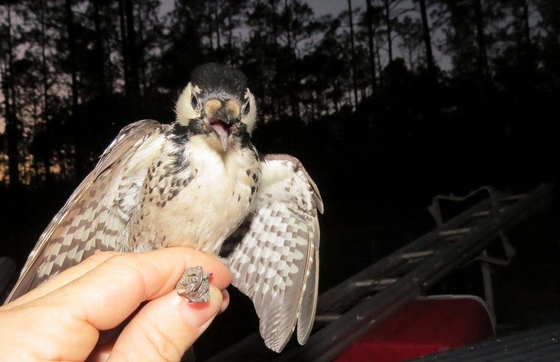 Red-cockaded woodpecker at Fort Stewart. (Charlie Muise/Audubon)
Red-cockaded woodpeckers at Moody Forest are reaping the benefits from habitat management, the largest Army installation in the East and the first DNR-owned property with these endangered birds. Here's how.
Operating under a cooperative agreement, The Nature Conservancy, which owns part of Moody Forest, and DNR have used prescribed fire, timber thins and groundcover restoration to restore and maintain woodlands at the 3,500-acre wildlife management area near Baxley.
“A lot of new woodpecker habitat is becoming available due to the work done by TNC and DNR,” said Joe Burnam, the Nongame Conservation Section biologist who leads red-cockaded woodpecker work for DNR.
Last week, DNR, Nature Conservancy and Fort Stewart biologists moved two male-female pairs of the woodpeckers from the 280,000-acre south Georgia military installation, where the species is thriving, to Moody Forest. In preparation, Burnam and The Nature Conservancy’s Chuck Martin added artificial cavity inserts – red-cockadeds nest and roost only in cavities in living pines – to form two new cluster sites. A cluster is the collection of cavity trees used by a family group of red-cockaded woodpeckers.
Before this month, Moody Forest had only one established family group, plus a lone male first seen on the WMA this year. To help the bachelor, DNR moved a female woodpecker from Silver Lake WMA to Moody Forest in October. The female had been banded this spring as a nestling at Silver Lake, near Bainbridge.
Acquired in 2008, Silver Lake was the first state-owned tract with red-cockaded woodpeckers (Moody Forest’s older group is on Nature Conservancy land). That made the translocation involving Moody the first for red-cockaded woodpeckers between populations on state lands.
All of the newcomers at Moody Forest are being monitored, and so far, so good.
“Hopefully we’re starting to trend up at Moody,” Burnam said.
RED-COCKADED WOODPECKERS AT A GLANCE
- Federally listed as endangered.
- Needs large expanses of mature, open pine forest.
- Nests and roosts only in cavities in old living pines. Excavating a cavity can take the birds several years.
- Range in Georgia: Historically, probably occurred in open, mature pine forests throughout the state, except the Blue Ridge Mountains. Populations are now centered at forts Stewart and Benning, Okefenokee National Wildlife Refuge, Piedmont NWR, plantations in the Red Hills region of Thomas and Grady counties, Joseph W. Jones Ecological Research Center, and Silver Lake WMA.
- Key threat: habitat loss and fragmentation.
-
Species profile
Back to top.
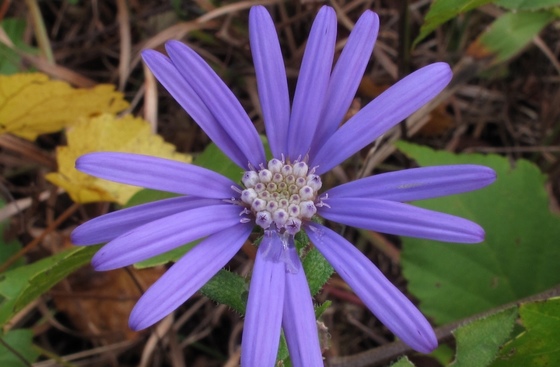 Georgia aster. (Alan Cressler)
In case you haven’t heard, the statewide strategy that is helping conserve hundreds of Georgia animal and plant species has been revised and is being put into practice following federal approval.
The U.S. Fish and Wildlife Service decision this fall on Georgia’s State Wildlife Action Plan clears the way for continued efforts and new projects focused on nearly 640 species considered high priorities for conservation. That lineup varies from golden eagles to gopher tortoises and Georgia aster wildflowers.
The new plan will guide work by DNR and its partners for the next 10 years, said Rusty Garrison, DNR Wildlife Resources Division director. “The Wildlife Action Plan sets our vision and our mission for how we’re going to manage these species.”
State Wildlife Action Plans are aimed at conserving populations of native wildlife and the habitats they need before the species become rarer and more costly to conserve or restore. An approved plan, reviewed at least every 10 years, also is required by Congress for DNR and wildlife agencies in other states to receive State Wildlife Grants, the main federal funding source for states to conserve animals not fished for or hunted. Georgia developed its initial Wildlife Action Plan in 2005.
Although the state is one of the most biologically diverse in the U.S., about 320 species in Georgia have such low populations they are state and federally protected. The Wildlife Action Plan lists 349 animal and 290 plant species as high conservation priorities, and recommends 150 actions to address their needs.
This work affects Georgians’ quality of life, helping preserve wildlife and wild places now and for future generations. It also strengthens the state's economy. Spending for wildlife-watching totaled an estimated $1.8 billion in 2011.
Back to top.
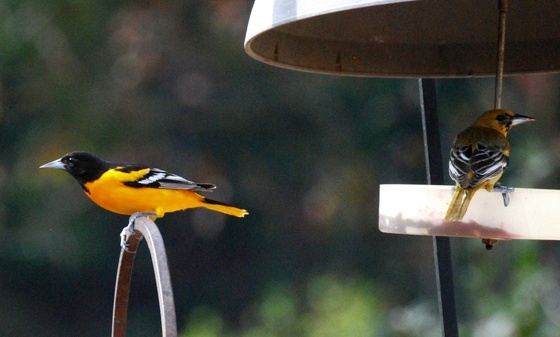 Baltimore orioles at the feeder. (Terry W. Johnson)
If you would like to have a Baltimore oriole in your backyard, there is no better time to try than now.
Honestly, the odds of spotting a Baltimore oriole in Georgia are low because the bird rarely nests here. Consequently, most people assume their only legitimate chance at seeing one of North America’s most beautiful birds is during fall or spring migration.
But there is another way. And as strange as it may sound, that way includes grape jelly or even powdered donuts. …
Intrigued? Read on to learn more about attracting these striking birds to your backyard. And since no one knows how many Baltimore orioles winter in Georgia, if you’re lucky enough to attract one or more, please email Terry.
Terry W. Johnson is a retired DNR nongame program manager and
executive director of TERN,
Nongame Conservation’s friends group. For more, check out Terry's Out My Backdoor
library and his blog, Backyard Wildlife
Connection.
Back to top.
 The newly released fiscal 2016 report for DNR’s Nongame Conservation Section documents a year's work, including successes and challenges, with Georgia’s rare animal and plant species and natural habitats.
The report comes in summary, comprehensive and story map versions. Review all or pick one that suits you at www.georgiawildlife.com/conservation/annualreport.
You can also short-cut to the story map by clicking the image above.
Questions or comments about the report? Please email editor Rick Lavender.
Back to top.
North Atlantic right whales are back. One was spotted off Sapelo Island Nov. 16, part of a migration in which these imperiled whales – as few as 465 remain – swim from feeding grounds off Canada and New England to the warmer waters of Georgia, South Carolina and north Florida to give birth and nurse their young in winter. Boaters cautioned. Follow sightings. Right whale photos. 2015-2016 review.
A Forsyth teacher’s proposal to create a bog garden out of a regularly flooded area at her school earned the $1,000 Conservation Teacher of the Year grant from DNR’s Nongame Conservation Section and its friends group TERN. Tiffany Smith, who teaches third grade at Samuel Hubbard Elementary, said she thought of Ben Franklin’s words when submitting the idea inspired by her students: “Tell me and I forget, teach me and I may remember, involve me and I learn.” Presentation photo.
Some 450,000 longleaf pines were planted on about 850 acres at Sprewell Bluff Wildlife Management Area last week. All costs were covered by CatchMark Timber Trust, a DNR Forestry for Wildlife Partner that has a timber lease on the tract and is working with DNR to restore the WMA near Thomaston.
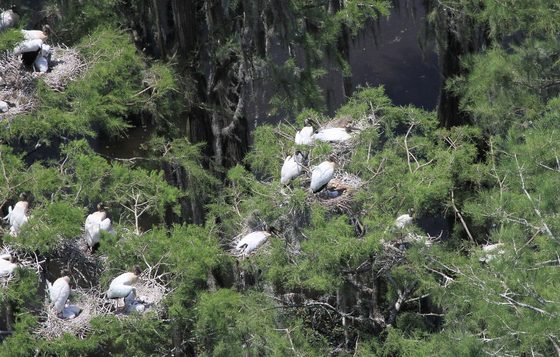 Wood stork colony in Brooks County this summer. (Tim Keyes/DNR)
Wood stork nesting in Georgia this spring and summer included 2,310 nests in 22 colonies, slightly down from last year’s 2,496 nests but still strong, according to DNR survey leader Tim Keyes. Nesting for the federally threatened wading birds varies year to year, but “we’re statistically on a generally increasing trajectory,” Keyes said. Report wood stork colony sites.
Most know that loggerhead sea turtles had a breakout year with 3,287 nests, a Georgia record since comprehensive surveys began in 1989 and far beyond a 2,800-nest recovery milestone. DNR Sea Turtle Project Coordinator Mark Dodd expects fewer nests next year but no reversal in the overall increasing trend for nesting, where even “our lower years are getting bigger.”
The north Georgia wildfires were contained by mid-December, thanks to the hard work of firefighters and welcomed rains. But most of Georgia remains in a drought – the northern half varies from severe to exceptional drought status – and visitors to federal and state lands should use caution when building, maintaining or putting out campfires. Related: a perspective on the wildfires and restorative prescribed fire from The Nature Conservancy’s Erick Brown.
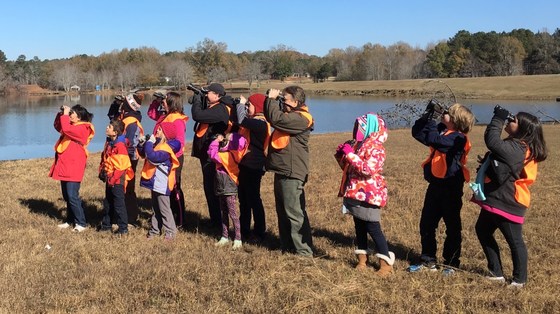 Group at the Charlie Elliott Youth Christmas Bird Count. (John Jensen/DNR)
After a successful inaugural youth Christmas Bird Count at Charlie Elliott Wildlife Center, a 2017 repeat is in the works. Many of the 42 youth and adults at the Dec. 10 count were new to birding, which matched the program of instruction centered on basics such as binocular use, time in the field with veteran birders, field guides for all and fun at lunch with prizes for teams spotting the most birds (169), the most species (33) and the coolest bird (brown creeper).
Georgia’s State Wildlife Action Plan has been named one of 100 most significant accomplishments in coastal resource stewardship by the conservation group 100 Miles. The awards, honoring people and organizations that have made a significant difference for Georgia’s coastal resources, will be presented Jan. 7 at the Jekyll Island Conference Center.
A donation of pitcherplants from Chattahoochee Nature Center for a bog garden at East Georgia State College in Swainsboro is pictured in this Flickr album. Chattahoochee’s Henning von Schmeling and DNR’s Rebecca Byrd helped student Norman Bevan and interim Biology Chair Dr. David Chevalier with the planting.
What is life like as an intern for the Coastal Georgia Cooperative Invasive Species Management Area? Learn about the group's projects and partnerships in this review of work done by interns Travis Mabe and Emily Hastings.
The Fishes of Georgia Photo Gallery has been revised to include the common name for species and fish families, such as lampreys and gars (Fishes ‘n Flicker, Nov. 1). Viewers using the Flickr mobile app can click the information (“i”) button to see the name and other data for each photo.
It’s official: Four freshwater turtle species have been added to Appendix III of the Convention on International Trade in Endangered Species of Wild Fauna and Flora. The change requires a permit to ship overseas common snapping and Florida, spiny and smooth softshell turtles – all native to Georgia except for smooth softshell – and will provide data on legal trade to help guide conservation.
Back to top.
 ’Tis the season for eastern indigo snake surveys. DNR senior biologist John Jensen (above) shows a 4.5-footer caught, checked and released Dec. 7 in Atkinson County. Also see photos from the field by The Orianne Society.
Names in the news: Kim Morris-Zarneke is the new business operations senior manager at DNR's Charlie Elliott Wildlife Center. Morris-Zarneke, who has more than 20 years of experience in environmental education and is a past president of the Environmental Education Alliance of Georgia, fills the position left vacant by Rusty Garrison, who is now director of DNR’s Wildlife Resources Division. Dr. Jennifer Cruse-Sanders has received the Marsh Christian Award for plant conservation from the Botanic Gardens Conservation International. Cruse-Sanders, vice president for Science and Conservation at Atlanta Botanical Garden, was presented the international award in London. An article in the Georgia Botanical Society journal Tipularia by DNR’s Dr. Mincy Moffett Jr. and Atlanta Botanical Garden's Carrie Radcliffe describes mountain bogs and the Georgia Plant Conservation's integral role in restoring and managing the habitat and flora of these "rare gems" of the southern Blue Ridge. Michele Elmore, former Chattahoochee Fall Line program director for The Nature Conservancy, is now an Athens-based U.S. Fish and Wildlife Service biologist focused on conserving longleaf pine ecosystems and rare plants.
Back to top.
COMING UP
Dec. 31-Jan. 1 – Wild night on Ossabaw Island, The Ossabaw Island Foundation. Registration deadline: Dec. 26.
Jan. 18 – Native Plant Symposium, The State Botanical Garden of Georgia, Athens
Jan. 22 – Red Hills Fire Festival, 11 a.m.-3 p.m., Tall Timbers Research Station & Land Conservancy, Tallahassee, FL
Jan. 27-28 – Weekend for Wildlife (annual DNR nongame fundraiser), The Cloister, Sea Island
Jan. 27-29 – Environmental Education Alliance’s Advanced Training for Environmental Education in Georgia – Core Course 1 (Foundations of Environmental Education), Charlie Elliott Wildlife Center, Mansfield. Also: March 31-April 2, ATEEG Core Course 2 (Fostering Learning); June 9-11, ATEEG Core Course 3 (Assessment and Evaluation)
WHAT YOU MISSED
In the last Georgia Wild:
-- A fish photo album, by family.
-- Networking for mountain bogs.
Back to top.
"NRCS releases two-year strategy to help gopher tortoise," USDA Natural Resources Conservation Service
"Right whales return to Georgia waters," Savannah Morning News (and others)
(+video) "This innovative buoy could help save some of the rarest whales in the world," PBS
"'Drought and fires impacts on wildlife and fish assessed," The (Dalton) Daily Citizen
"A holiday story: Small-town school wins prize for big idea inspired by pupils," SaportaReport. Also: Monroe County Reporter.
"Stopping an extinction of bats," Pittsburgh Post-Gazette
"Tropical Storm Hermine, Hurricane Matthew damaged eagle nests," The Florida Times-Union
"DNR offering reward for who shot, dumped great blue heron by dumpster," WRDW-TV (Ch. 12, Augusta)
"Study doubles estimate of world bird species," American Museum of Natural History
"Midstate bear population higher than thought, research suggests," The (Macon) Telegraph
"Georgia's revised Wildlife Plan approved and at work," Chattanoogan.com
"Cougar sighting verified in northeast Louisiana," Louisiana Department of Wildlife & Fisheries
"Chattahoochee students welcome real and stuffed owls," Forsyth County News
"UGA researchers calculating bobwhite population, survival rates," UGA Today
"Plastic bottles, cave divers aid in quest to document subterranean critter (Georgia blind salamanders)," Earth Island Journal
"Sea turtle nests on upward trend," South Strand News (Georgetown, S.C.)
"Conservation effort spreads seeds of destruction across Midwest," University of Illinois at Urbana-Champaign
"Supersize me: remains of three deer in invasive Burmese python in Florida," Regional Euro-Asian Biological Invasions Centre
"Brazil’s invasive pigs feeding rabid vampire bats," The Washington Post
VIDEO & AUDIO
(video) "New wildlife plan aims at preserving local species and their habitats," WGXA-TV (channels 24, 16, Macon)
(audio) "Southern states scrambling to contain wildfires" (quotes DNR), NPR
(audio) "The eagle eye," BirdNote
Back to top.
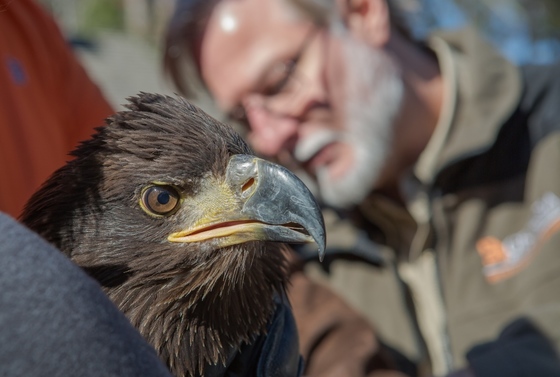 DNR's Todd Schneider bands the eagle before its release. (Gena Flanigan)
A young bald eagle found tangled in fishing line on the Etowah River this summer was rehabilitated by Auburn University’s Southeast Raptor Center and released at Lake Allatoona Dec. 10. A crowd of more than 100 that showed at Red Top Mountain State Park were told about the rescue, the recovery and the state of eagle conservation in Georgia. All then thrilled at the sight of the released eagle flying strong to a large pine before taking off again, circling the cove and flying out of sight. See more Gena Flanigan photos and read a news account of the release.
3 THINGS YOU CAN DO
To help conserve bald eagles and other rare species and their habitats:
1. Buy or renew an eagle or hummingbird license plate. These tags support DNR’s Nongame Conservation Section, which depends largely on such fundraisers to conserve rare and other species not legally hunted or fish for, and their habitats.
2. When filing your taxes, contribute to the Georgia Wildlife Conservation Fund state income tax checkoff. All donations help conserve nongame. They'll also help reverse a 2016 downturn of only $131,248 in donations, the least since the checkoff’s start in 1989 and less than half the annual average contributed.
3. Learn more about bald eagles and other rare animals and plants. Resources vary from DNR’s rare species profiles to Berry College’s bald eagle nest cam. (Tip: In three of the last four years, the Berry eagles laid their first egg as early as Jan. 6 and no later than Jan. 14. Stay tuned on Berry's website and at www.georgiawildlife.com/cams.)
Back to top.
Masthead image: Rehabilitated eagle released at Allatoona. (Gena Flanigan)
|